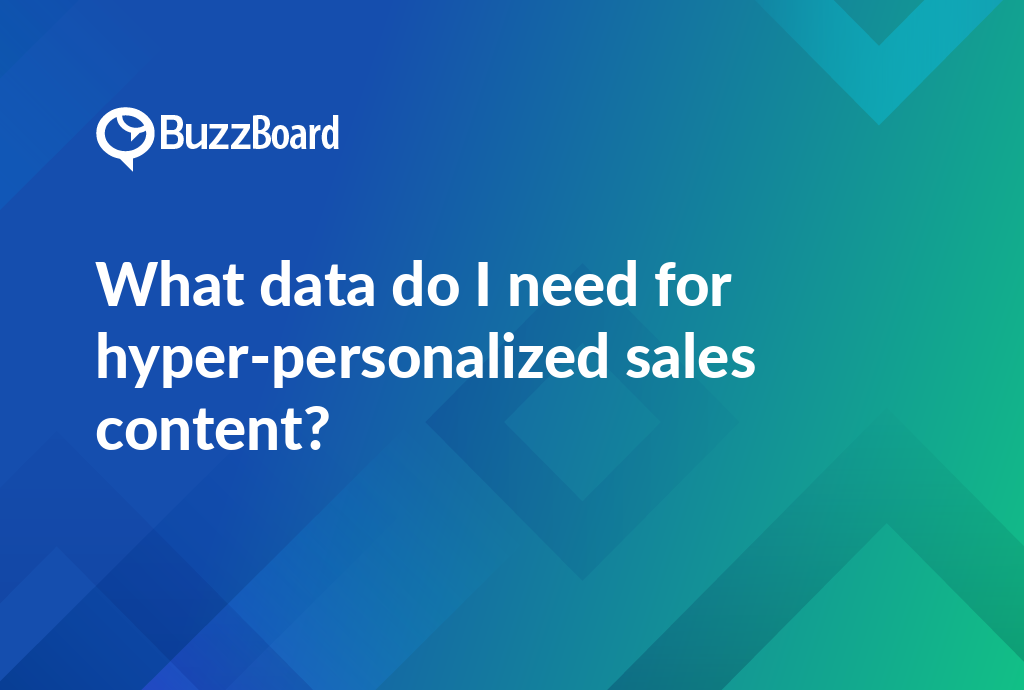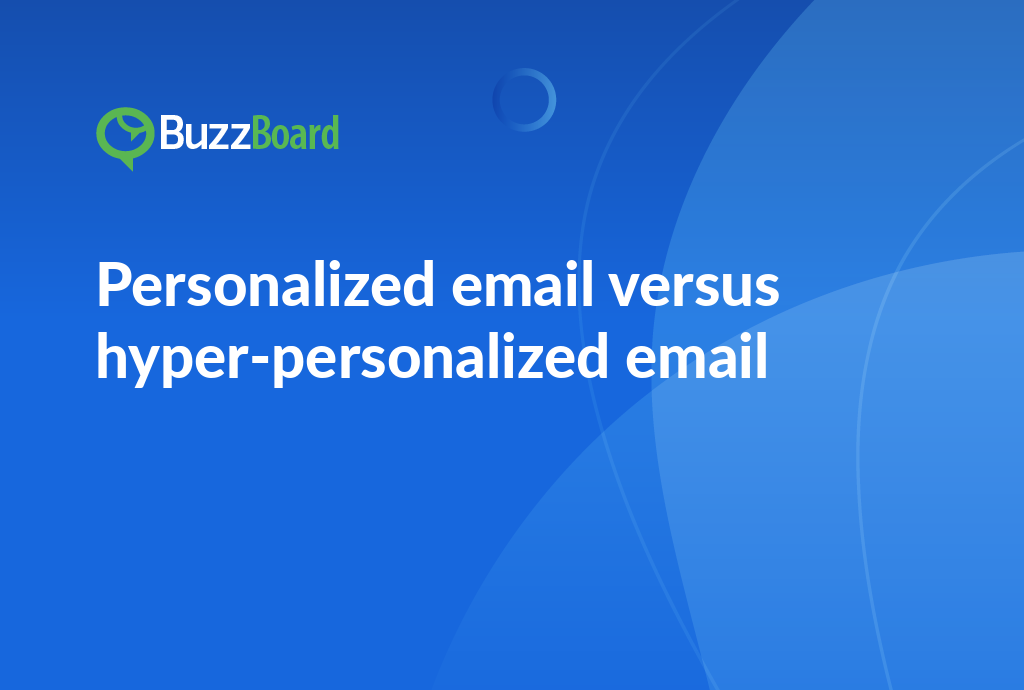To create hyper-personalized sales content, you’ll need a combination of customer data, behavioral data, and transactional data. This includes demographic information such as age, location, and job title, as well as behavioral data like browsing history, search queries, and purchase behavior. Additionally, you’ll need transactional data like purchase history, order frequency, and average order value. By leveraging these data points, you can create highly targeted and relevant sales content that resonates with your audience and drives conversions.
Discuss the Importance and the Role of Data in Creating Hyper-Personalized Sales Content
Data is imperative as the catalyst for hyper-personalized sales content. For digital marketing agencies serving small businesses, this concept is critical, as data lays the foundation for sales enablement. Sales representatives can smoothly facilitate their sales process by effectively leveraging data and creating customized, potent sales collateral.
So, how does data foster hyper-personalization? There are three primary functions for sales representatives. Firstly, data offers insights into customer behavior patterns, needs, and preferences. Hence, representatives can create super-relevant sales content that aligns with their intended audience.
Secondly, data provides valuable insights into customer interaction trends, offering sales representatives a comprehensive understanding of the most effective communication channels and engagement strategies that resonate with different customers. By leveraging these insights, representatives can refine their sales process to ensure it is uniquely tailored to each customer’s preferences, needs, and behaviors. This hyper-personalization enables sales teams to build stronger relationships with customers, increase customer satisfaction, and ultimately drive revenue growth.
Moreover, data analysis can help identify patterns and correlations between customer interactions, sales outcomes, and other key performance indicators. This information can be used to optimize the sales process, streamlining it to focus on the most effective strategies and tactics that yield the best results. By continuously refining their approach, sales representatives can adapt to changing customer needs and preferences, stay ahead of the competition, and maintain a competitive edge in the market.
Lastly, data plays a crucial role in shaping a feedback loop that enables sales representatives to assess the performance of their sales collateral, including sales materials, presentations, and pitches. By analyzing customer interactions and feedback, representatives can identify areas for improvement, refine their messaging, and recalibrate their strategies to better resonate with customers. This continuous cycle of improvement enables sales teams to refine their approach, increase their effectiveness, and ultimately drive business success.
In summary, data-driven hyper-personalization is a powerful tool that sales representatives can employ to contribute to the business success of their clients. By leveraging data insights, sales teams can build stronger relationships with customers, optimize their sales process, and refine their strategies to drive revenue growth and customer satisfaction.
Reveal What Types of Data Are Essential for Building Hyper-Personalized Sales Content and How to Collect Them
In the realm of digital marketing, leveraging data for hyper-personalized sales content can unlock new pathways to sales enablement, particularly when targeting small and local businesses. At its core, hyper-personalization enables the creation of sales content that genuinely resonates with individual prospects, thereby amplifying sales effectiveness.
To construct a robust hyper-personalization strategy, it’s essential to harness two critical types of data: demographic and behavioral. Demographic data encompasses a prospect’s age, gender, occupation, location, and income, providing a comprehensive portrait of your audience. This data can be amassed through various means, including:
- Surveys and quizzes: Conducting surveys or quizzes can help gather valuable demographic information about your prospects, allowing you to tailor your sales content to their specific needs and interests.
- Existing client datasets: Analyzing existing client datasets can provide valuable insights into your target audience’s demographics, enabling you to create targeted sales content that speaks directly to their needs.
Behavioral data, on the other hand, pertains to the activities of your potential customers. This can include:
- Website visits: Tracking website visits can provide insights into a prospect’s interests, such as which pages they visit most frequently or how long they spend on your site.
- Content downloads: Monitoring content downloads can help you understand what types of content resonate with your prospects, allowing you to create more targeted sales content.
- Social media activity: Analyzing social media activity can provide valuable insights into a prospect’s interests, preferences, and behaviors, enabling you to create more personalized sales content.
- Previous purchases: Examining previous purchases can help you understand a prospect’s purchasing habits, allowing you to create targeted sales content that speaks directly to their needs.
Gathering behavioral data can be facilitated through various tools and applications, including:
- Google Analytics: This powerful analytics tool can help you track website visits, content downloads, and other online behaviors, providing valuable insights into your prospects’ interests and behaviors.
- Social media analytics: Many social media platforms offer built-in analytics tools that can help you track engagement, clicks, and other online behaviors, providing valuable insights into your prospects’ interests and behaviors.
Once you’ve amassed both demographic and behavioral data, it’s essential to efficiently utilize these relevant datasets within your sales materials. This can be achieved by:
- Personalizing emails: Use demographic and behavioral data to create personalized emails that speak directly to a prospect’s interests, needs, and preferences.
- Designing targeted content: Use demographic and behavioral data to create targeted content that resonates with individual prospects, such as creating content that speaks directly to their pain points or interests.
- Offering tailored solutions: Use demographic and behavioral data to create tailored solutions that meet the specific needs and preferences of individual prospects.
By applying hyper-personalization in a thoughtful and strategic manner, you can connect with your prospects at a more profound level than a typical sales pitch, increasing the likelihood of conversion and driving business growth.
Showcase Some Practical Examples or Case Studies Where Hyper-Personalization in Sales Content Has Proved Successful
Sales representatives must stay ahead of the curve by embracing the latest trends and strategies to maintain their competitive edge. One such trend that is gaining significant traction is the emphasis on hyper-personalization in sales content. This approach involves leveraging data to craft ultra-personalized content that resonates deeply with customers, ultimately enhancing sales outcomes and driving business growth.
The benefits of hyper-personalization in sales content are evident in the success stories of companies like Marketo, a leading marketing software company. By revitalizing their sales content and collateral through a hyper-personalized approach, Marketo was able to reap significant rewards. To achieve this, they gathered various sources of data to design personalized messages that addressed the unique needs and pain points of individual clients. The results were impressive: Marketo experienced a 20% increase in sales enablement and a more than 50% reduction in the sales process time. This significant improvement in efficiency and effectiveness enabled Marketo to better engage with customers, build stronger relationships, and ultimately drive more sales.
Another compelling example of the power of hyper-personalization in sales content is Servicenow, a service management company. By utilizing data-derived insights to examine their customers’ behavior, Servicenow adopted hyper-personalized tactics in their sales content. As a result, they saw a 15% surge in their annual recurring revenue (ARR). This significant increase in revenue demonstrates the impact that hyper-personalization can have on a company’s bottom line.
These success stories underscore the importance of hyper-personalization in sales content and highlight the potential benefits that companies can achieve by applying data-driven strategies. By leveraging data to create personalized messages and content, sales representatives can build stronger relationships with customers, increase engagement, and ultimately drive more sales.
So, how can you reinvigorate your sales game by integrating hyper-personalized sales content? Here are some actionable steps you can take:
- Start by gathering data: Collect various sources of data, including customer behavior, preferences, and pain points, to gain a deeper understanding of your target audience.
- Analyze the data: Use data analytics tools to analyze the data and identify patterns, trends, and insights that can inform your sales content.
- Design personalized messages: Use the insights gained from data analysis to design personalized messages that resonate with individual customers.
- Create ultra-personalized content: Use the data to create ultra-personalized content that addresses the unique needs and pain points of individual customers.
- Integrate data-driven tools and strategies: Utilize data-driven tools and strategies, such as marketing automation software, to streamline your sales process and enhance customer engagement.
- Continuously monitor and refine: Continuously monitor the effectiveness of your hyper-personalized sales content and refine your approach as needed to ensure optimal results.
By following these steps and embracing the power of hyper-personalization in sales content, you can stay ahead of the competition, drive more sales, and ultimately achieve greater success in the digital marketplace.
Elaborate on How the Use of Data for Hyper-Personalization Can Streamline the Sales Process and Improve Sales Enablement
The integration of data for hyper-personalized sales content is transforming the sales enablement landscape in digital marketing agencies, particularly when it comes to engaging with small and local businesses. By leveraging ultra-specific, personalized content, sales teams can streamline the sales process, enhance conversion rates, and craft impactful sales collateral that resonates with prospects, enticing them one step closer to conversion.
Hyper-personalization provides sales representatives with a granular understanding of their potential client base, allowing them to generate targeted, relevant content that captures attention and drives engagement. By drawing on behaviors, interests, and preferences, sales teams can create tailored content that makes prospective clients feel valued, fosters trust, and increases the likelihood of conversion by anticipating customer needs.
Moreover, data from hyper-personalization removes the guesswork and shortens the sales cycle, stimulating revenue growth and business sustainability. By investing in reliable tools and solutions for generating insightful, actionable data, sales teams can streamline their process, fostering efficiency and producing better results. The more specific the content, the more significant the conversions will be.
In today’s competitive digital landscape, hyper-personalization is no longer a nice-to-have, but a must-have for sales teams looking to stay ahead of the curve. By embracing this approach, sales teams can:
- Increase customer acquisition rates by crafting content that speaks directly to the needs and interests of potential clients
- Improve customer retention by providing personalized experiences that build trust and loyalty
- Boost revenue growth by streamlining the sales cycle and reducing the time spent on unqualified leads
- Enhance brand reputation by delivering tailored content that resonates with prospects and builds credibility
To reap the benefits of hyper-personalization, sales teams must invest in reliable tools and solutions that can generate insightful, actionable data. This may include:
- Customer relationship management (CRM) software that provides detailed insights into customer behavior and preferences
- Marketing automation platforms that enable the creation of targeted, personalized content
- Data analytics tools that provide real-time insights into customer engagement and conversion rates
By embracing the power of hyper-personalization, sales teams can revolutionize their approach to sales enablement, driving greater efficiency, effectiveness, and revenue growth. As the sales landscape continues to evolve, hyper-personalization will play an increasingly important role in helping sales teams stay ahead of the curve and achieve their goals.
Provide Actionable Tips on How to Best Utilize Data for Creating Hyper-Personalized Sales Collateral
Sales representatives must grasp the significance of data utilization in crafting hyper-personalized sales collateral. This concept, deeply rooted in sales enablement, begins with a thorough analysis of your target businesses’ behaviors, interests, and demographics. By leveraging this data, you can create sales content that resonates with your audience, ultimately driving conversions and revenue growth.
To harness this data effectively, it’s essential to integrate it into every stage of your sales process. A valuable first step would be incorporating it into your Customer Relationship Management (CRM) system. This allows for the crafting of sales content that is directly tailored to your client’s specific needs and challenges. By analyzing customer interactions, purchase history, and other relevant data points, you can create targeted sales collateral that speaks directly to their pain points and interests.
The next step is to employ the collected data to formulate customer personas that communicate to the key audience targeted by your small or local business. Taking a cafe as an example, it might have multiple personas such as morning coffee drinkers, lunch crowd, or students studying in the evening. Each of these personas has unique characteristics, behaviors, and preferences that require different sales collateral to genuinely resonate with them. By creating separate sales collateral for each persona, you can ensure that your message is tailored to their specific needs and interests, increasing the likelihood of conversion.
The deployment of sales enablement software aids this process, offering a centralized platform to manage, distribute, and scrutinize your personalized sales content’s performance. Applications such as Salesforce or HubSpot can animate your sales collateral and deliver it in the most effective manner, allowing you to track engagement metrics, measure ROI, and refine your strategy accordingly.
However, the secret to fruitful data-driven personalization is not just about collecting and analyzing data, but also about the constant analysis and refinement of your sales collateral. Progress tracking on your initiatives and necessary improvements are crucial to creating engaging, hyper-personalized sales collateral. This requires ongoing monitoring of customer interactions, feedback, and performance metrics to identify areas for improvement and optimize your sales strategy.
To achieve this, consider the following best practices:
- Regularly review and update your customer personas to ensure they remain relevant and accurate.
- Continuously analyze customer feedback and sentiment to identify areas for improvement.
- Track key performance indicators (KPIs) such as engagement rates, conversion rates, and sales revenue to measure the effectiveness of your sales collateral.
- Refine your sales collateral based on performance data, making adjustments to messaging, design, and distribution channels as needed.
- Utilize A/B testing and experimentation to validate assumptions and identify the most effective sales collateral for each persona.
By following these best practices and embracing the power of data-driven personalization, sales representatives can create sales collateral that resonates with their target audience, drives conversions, and ultimately drives revenue growth.
Conclusion
Creating hyper-personalized sales content requires a deep understanding of your customers and their behavior. By leveraging the right data, you can create targeted and relevant content that speaks directly to your audience’s needs and preferences. From demographic information to behavioral and transactional data, there are many different types of data that can be used to inform your sales content strategy.
By combining these data points, you can create a comprehensive picture of your customers and tailor your content to their unique needs and interests. This can help to increase engagement, drive conversions, and ultimately, boost your bottom line.
Remember, the key to successful hyper-personalization is to be data-driven and to continually refine and improve your approach based on the insights you gather. By staying focused on your customers and adapting to their changing needs and preferences, you can create a sales content strategy that truly stands out from the competition and drives real results.









